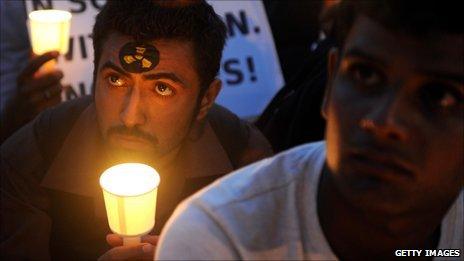Fears rise in India of Fukushima-style nuclear disaster
- Published

A leading campaigner against a massive nuclear power plant in India has pledged that villagers are ready to sacrifice their lives in order to prevent a repeat of Japan's nuclear disaster.
Praveen Gavhankar, a farmer and fruit transporter, said he and thousands of villagers in western Maharashtra, had become totally frustrated over the government's determination to allow the construction of six large reactors at Jaitapur, in an active earthquake zone.
"And so," said Mr Gavhankar, "the people have decided that, rather than letting a Fukushima happen in Jaitapur fifteen years later, it's better to die today and stop the plant."
Mr Gavhankar was speaking on his attractive farmstead not far from the nuclear site, as family members worked in the fields nearby preparing the land for the rainy season.
Last week a 30 year old man was shot dead by police after protesters from a village near the nuclear site invaded their local police station.
Disagreement
There is sharp disagreement between the authorities and independent experts about how severe the earthquake risk is for Jaitapur, which is about a day's journey by road south of Mumbai.
The Nuclear Power Corporation of India, which runs the country's civil reactors, has claimed the Jaitapur site lies in earthquake Zone 3. The risk scale runs from 1 to 5 - with Zone 5 denoting severe risk.
But the BBC has been told by a leading expert on the geology of Maharashtra that the planned nuclear site falls into an area of higher risk - Zone 4.
Retired university professor, Dr M.K. Prabhu, is dismayed at the plan to site six nuclear reactors at the Jaitapur site.
"I am not in favour of that one at all," says Dr Prabhu. "As far as geology is concerned it is not in a stable area."
He also believes the seismic risk could be growing.
"Evidence shows…even higher magnitude earthquake can happen in this area," says Dr Prabhu.
Nuclear risk
The line taken by the geologist is supported by a former safety regulator for the nuclear power industry in India.
Dr A Gopalkrishnan, who chaired the Atomic Energy Regulatory Board in the mid 1990s, says that for the sake of public protection, experts who judge the nuclear site to be in the more risky Zone 4 should be given the benefit of the doubt.
"In any case where there is a dispute between Zone 3 and Zone 4, from a …safety point of view, it is always prudent, and you must, take Zone 4 for the basis of this design."
However the chief government spokesman on nuclear power insists that the Jaitapur site is in the less risky category, Zone 3.
S.K. Malhotra, Head of Public Awareness at the Department of Atomic Energy, says that there is a big difference between the level of seismic risk in Japan and that in India.
"The whole of Japan is sitting on seismic Zone 5", says Mr Malhotra.
"Except for one power station, all our power stations, nuclear reactors, are situated in seismic Zone 2 or 3."
Growing fears
But in the wake of the Fukushima crisis in Japan fears have also been growing among people living near one of India's existing nuclear plants, also on the coast of Maharashtra.
The Tarapur power station is about two hours by road or rail from India's business powerhouse, Mumbai.
Two of Tarapur's four units are boiling water reactors, very similar in age and type to the reactors at Fukushima which suffered grave damage, causing releases of radiation, after the tsunami which struck Japan in March.
One local leader at Tarapur says that the two older units, dating from 1969, and supplied by the American engineering giant, General Electric, have already run for 16 years longer than their design lives.
"I think it should be shut down," said Jitendra Raul, leader of Tarapur Progress Community. "Should we wait till the time there is some big incident or some big blast inside the power plant?"
Close reactors
Former nuclear safety regulator Dr A. Gopalkrishnan revealed that he had been told in 1995 by American nuclear authorities that India would be well advised to close the reactors.
"Even in 1995," says Dr Gopalkrishnan, " I have been advised by…the US Dept of Energy and the Nuclear Regulatory Commission it'll be safer to shut down the Tarapur 1 and 2 reactors."
"And I have conveyed this message back to the government of India but the government decided to ignore that at that time."
However the current chairman of India's Atomic Energy Regulatory Board, S.S. Bajaj, says that safety upgrades were made to the reactors about 10 years ago, to lower the risks in case of a total loss of power or "station blackout".
Now, he says, following the nuclear crisis in Japan, a fresh and wide-ranging look at safety in India is under way.
"Now after this Fukushima accident we are reviewing the safety of all our plants," says Mr Bajaj.
"In this investigation we are doing, if it shows we need to further strengthen, we will do that strengthening," he said.
- Published26 April 2011
- Published19 April 2011
- Published19 April 2011
- Published14 March 2011